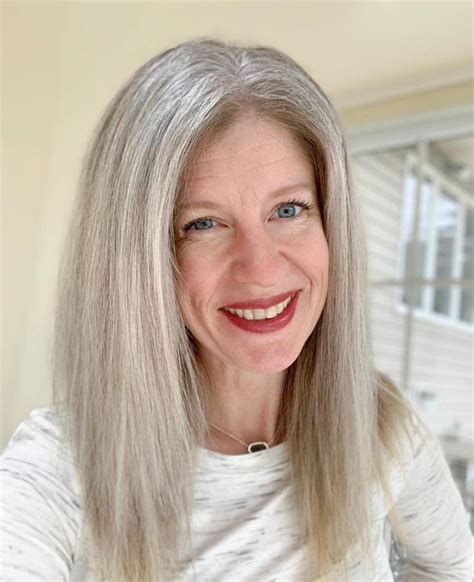As we age, our hair naturally grays, a process influenced by genetics, hormonal changes, and environmental factors. While some women embrace their gray hair, others may feel the need to cover it up. This article explores the reasons behind gray hair, its implications, and strategies to navigate this transition. By understanding the science, addressing societal biases, and celebrating the beauty of silver strands, we can empower women to make informed choices about their hair and embrace their natural aging process.

Science Behind Gray Hair
Gray hair occurs when the pigment-producing cells in our hair follicles, called melanocytes, gradually decrease in number and activity. This reduction leads to a decrease in melanin, the pigment responsible for hair color, resulting in the appearance of gray strands.
Facts and Figures:
- According to the American Academy of Dermatology, by age 50, approximately 50% of the population will have at least 50% gray hair.
- The average age at which people start to notice gray hair is 35 for women and 40 for men.
- Genetics play a significant role in determining when we start to turn gray, with some people experiencing it earlier than others.
- Hormonal changes, such as those during menopause, can also accelerate the graying process.
Societal Biases and the Stigma of Gray Hair
Gray hair has long been associated with aging, wisdom, and maturity. However, in some cultures and workplaces, it can carry negative connotations of decline and unattractiveness, particularly for women. This stigma has influenced many women to color their hair or adopt other measures to hide their gray strands.
Impact of Bias:
- A study by the University of Kent found that women with gray hair were perceived as less attractive, less competent, and older than women with colored hair.
- Women who dye their hair are often motivated to do so because they feel they will be judged negatively if they have gray hair.
- The stigma surrounding gray hair can lead to feelings of insecurity and anxiety, particularly in younger women.
Strategies for Embracing Gray Hair
Embracing gray hair is a personal choice, and there are strategies that can help women navigate the transition and feel confident in their decision.
Gradual Transition:
- If the transition to gray hair seems overwhelming, consider gradually incorporating gray highlights into your current hair color. This can help ease the adjustment and make the overall change less noticeable.
Experiment with Color:
- While gray hair is naturally silver or white, there are various hair coloring options available to enhance or tone the gray. Consider adding warmth with golden or beige undertones or using a toner to remove any unwanted yellow or brassiness.
Style to Enhance:
- Embrace the natural texture of gray hair, which is often coarser and more voluminous. Use volumizing products and styling techniques to create a flattering shape and enhance its movement.
Celebrate the Journey:
- Gray hair is a sign of experience and maturity, and it can be celebrated as a transition to a new stage in life. Embrace the journey of aging and focus on self-acceptance and empowerment.
Pros and Cons of Embracing Gray Hair
Pros:
- Saves Time and Money: No more costly hair coloring appointments or root touch-ups.
- Natural Beauty: Gray hair can be a unique and striking feature that enhances natural beauty and character.
- Reduced Chemical Exposure: Eliminates the need for harsh hair dyes, reducing exposure to chemicals.
- Confidence and Empowerment: Embracing gray hair can boost confidence by fostering self-acceptance and challenging societal norms.
Cons:
- Transition Period: The initial transition phase can be challenging, especially for those who are used to coloring their hair.
- Negative Stereotypes: Gray hair can still be subject to negative stereotypes and societal biases.
- Yellowing or Brassiness: Gray hair can sometimes develop unwanted yellow or brassy tones, which may require additional care or color correction.
- Uneven Graying: Gray hair may not always grow in evenly, leading to a patchy or uneven appearance.
Innovative Applications for Women’s Gray Hair
In addition to embracing gray hair as a natural beauty feature, researchers are exploring innovative applications that leverage its unique properties.
- Hair Care Products: Gray hair has a different texture and chemical composition than colored hair, inspiring the development of specialized hair care products designed to address its specific needs, such as volumizing shampoos and conditioners.
- Textile Industry: The silver fibers extracted from gray hair have been incorporated into textiles, creating fabrics with antimicrobial and moisture-wicking properties.
- Cosmetics: Silver ions contained in gray hair have antibacterial and anti-inflammatory properties, which are being harnessed in the development of cosmetics and skincare products.
- Medical Applications: Researchers are investigating the potential applications of gray hair in regenerative medicine, due to its ability to promote cell growth and repair.
Customer Engagement and Questions
Engaging with customers on the topic of women’s gray hair can help validate their perspectives and provide valuable insights. Here are some thought-provoking questions to ask:
- What are your thoughts and feelings about gray hair? How does it impact your self-perception?
- Have you experienced societal pressure or bias related to gray hair? How did it affect you?
- What strategies have you found helpful in embracing or transitioning to gray hair?
- What innovative applications or uses for gray hair would you be interested in learning more about?
Conclusion
Women’s gray hair is a multifaceted topic that encompasses science, societal norms, and personal choices. By understanding the reasons behind gray hair, addressing the associated biases, and exploring strategies for embracing it, women can make informed decisions that align with their values and self-image. Embracing gray hair is not just about changing the color of our hair but about embracing the natural aging process and challenging societal stereotypes. It is a journey of self-acceptance, confidence, and empowerment that celebrates the unique beauty and wisdom that comes with age.
